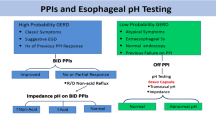Abstract
Esophageal 24-h pH monitoring was performed in addition to esophagogastrography, esophageal manometry, and esophagoscopy in 66 infants and 12 children from 2–14 years of age with symptoms characteristic of gastroesophageal reflux (GER). In ten infants, ph monitoring was repeated once or twice at intervals of 1 week to 8 1/2 months. The follow-up time for all patients ranged from 2–7 years. Our findings suggest that extended pH monitoring is the most valuable diagnostic procedure under the following circumstances. First, when there are major discrepancies between reported observations and actual symptoms during hospitalization, pH monitoring can clarify the causal relationship. Second, when symptoms are milder but presistent, documentation of prolonged episodes of reflux — overall and during sleep — can aid in determining the urgency of endoscopy. Third, the effectiveness of individual therapeutic measures is best objectivized by means of extended pH monitoring. On the other hand, the procedure is not in defining prognosis or the need for surgical therapy.
Similar content being viewed by others
Author information
Authors and Affiliations
Rights and permissions
About this article
Cite this article
Koch, A.W. Extended pH-monitoring in the evaluation of gastroesophageal reflux in infancy and childhood. Pediatr Surg Int 1, 161–167 (1986). https://doi.org/10.1007/BF00180917
Issue Date:
DOI: https://doi.org/10.1007/BF00180917




